The Be Quiet! Silent Base 600 ATX Case Review
by E. Fylladitakis on November 17, 2016 9:00 AM EST- Posted in
- Cases/Cooling/PSUs
- be quiet!
- ATX
- Case
- Silent Base 600
The Exterior of the Be Quiet! Silent Base 600
Be Quiet! tried to aesthetically balance the Silent Base 600, with the simple geometric shapes forming an understated, yet modern design. It is an all-black case with a colored trim surrounding the front intake air vents and the windowed side panel. The Silent Base 600 is available with its trim colored orange, black or silver; we received the orange version for this review. The matte black paint is very smooth and flawlessly applied, with an excellent feel to the touch, but its treated surface is like a sponge for fingermarks.
The proportions of the Silent Base 600 are normal for an advanced ATX case, with the exception of the extended width to allow for the support of more advanced cooling options. It measures 49.5 cm tall, 23.5 cm wide and 48.2 cm deep (19.5 × 9.25 × 19.4 in), which results to a volume of 57.3 liters. It shared almost the same volume as the BitFenix Pandora ATX and the Corsair Carbide 600Q (57.8 and 57.1 liters respectively), yet its width makes it significantly larger than a basic ATX case such as the Zalman Z9 Neo (48.4 liters).
11.2 oz soda can inserted as a size reference
Be Quiet! placed the front I/O ports at the top of the faceplate, on a roughly 30° angle, making it very convenient for the user to access them if the case is placed on or near the floor. There are two USB 2.0 ports, two USB 3.0 ports and the standard 3.5mm headphone jacks. The system's power on button is found at the top of the case and is a large, square button with an illuminated power logo. A small LED near the front of the case displays the HDD activity. There is no reset buton.
The magnetic faceplate door opens from right to left, revealing a black plastic fascia with three 5.25” drive slots. A thick layer of sound absorbing material is installed to the inside of the door. The front air intake filter is very conveniently accessible from here, removable by simply pulling it upwards. A close inspection above the 5.25" bays reveals a very small three-way switch, which is used as a basic but effective fan speed controller.
This is one of the few cases with a fan slot on the right side panel. The elegant square decorative plastic cover at the center of the right panel can be adjusted to allow for the installation of a 120 mm intake or exhaust fan. A simple metallic mesh dust filter is preinstalled into the slot. However, the installation of even a thin 120 mm fan on the right side of the case offers virtually no practical advantage and will cause several clearance issues. Even though it is possible to install a fan on the right side panel, the company does not recommend it. The design of the right side panel simply is identical to that of the left side panel of the non-windowed version of the case. Thick sound-dampening material is installed on the right side panel.
The vents at the top cover are very narrow, most likely designed so as to reduce the direct transfer of sound waves from the interior of the case, dampening the noise of the system. The user however needs to be careful with the selection of the fans, as very high airflow fans will cause the narrow openings to generate aerodynamic noise, negating any positive effects from this design.
A look at the rear of the Be Quiet! Silent Base 600 hints a lot about it design. The PSU compartment is found at the bottom of the case, vents are formed next to the expansion card covers and on the covers themselves, with a 120 mm exhaust fan right above them. The core concept of the design obviously is to draw air in as silently as possible via indirect openings at the front of the case and use positive pressure to force the air out of the rear of the case. The three round openings with the rubber grommets also hint that there is no room for very large liquid cooling systems inside the system area, but the designer thoughtfully offered the option to install an external liquid-based cooling system.
The Silent Base 600 stands on four very tall, square plastic feet with rubber anti-slip pads installed. These tall feet improve the bottom air intake of the case from the (optional) fan and the PSU. A nylon filter can be seen covering the PSU intake, which can be removed from the back of the case.



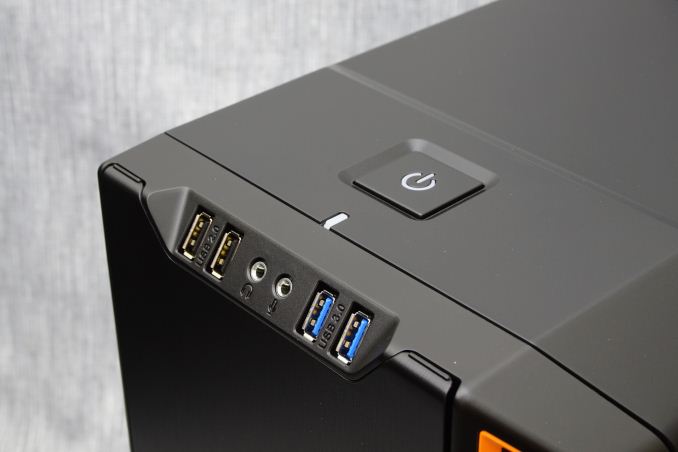
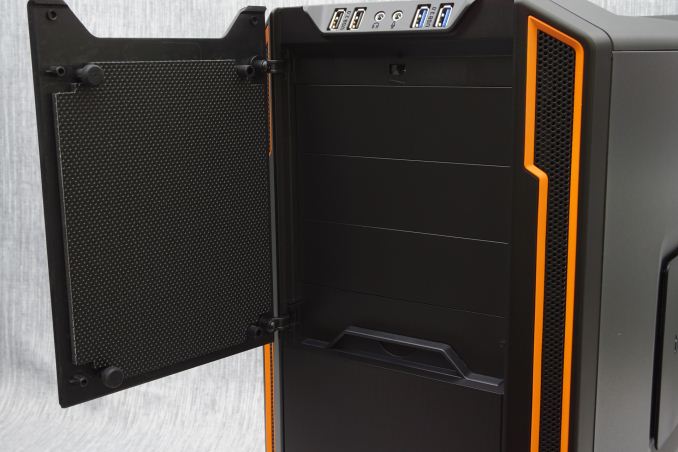
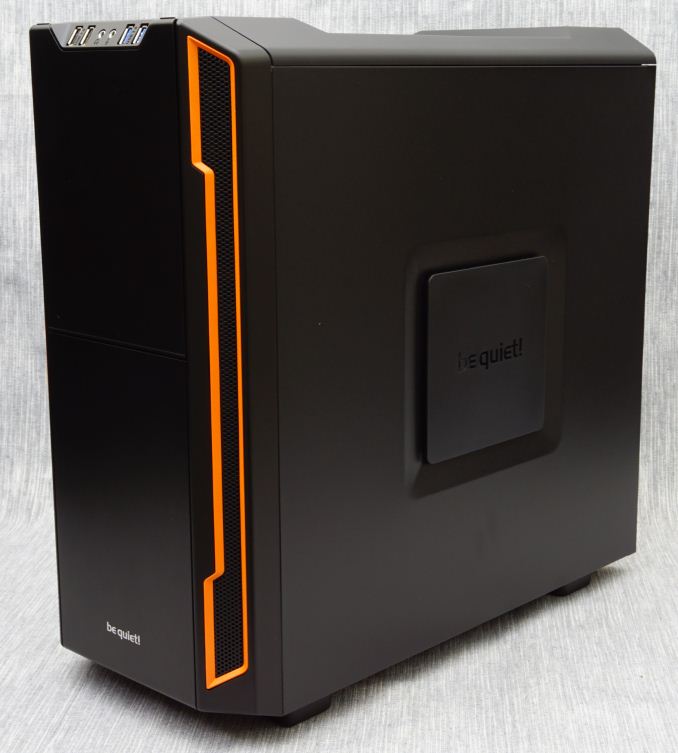
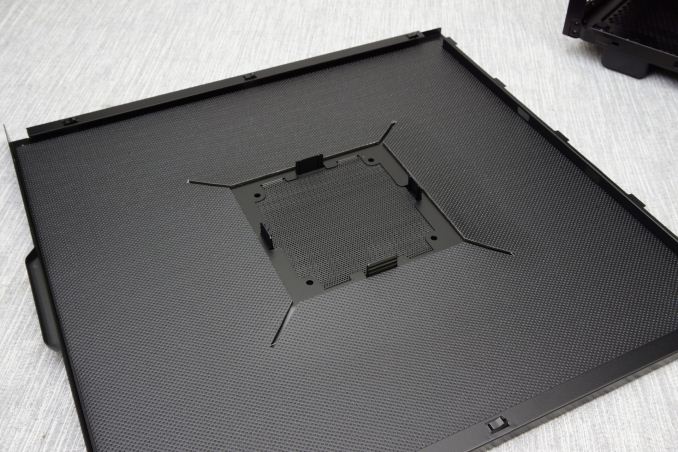

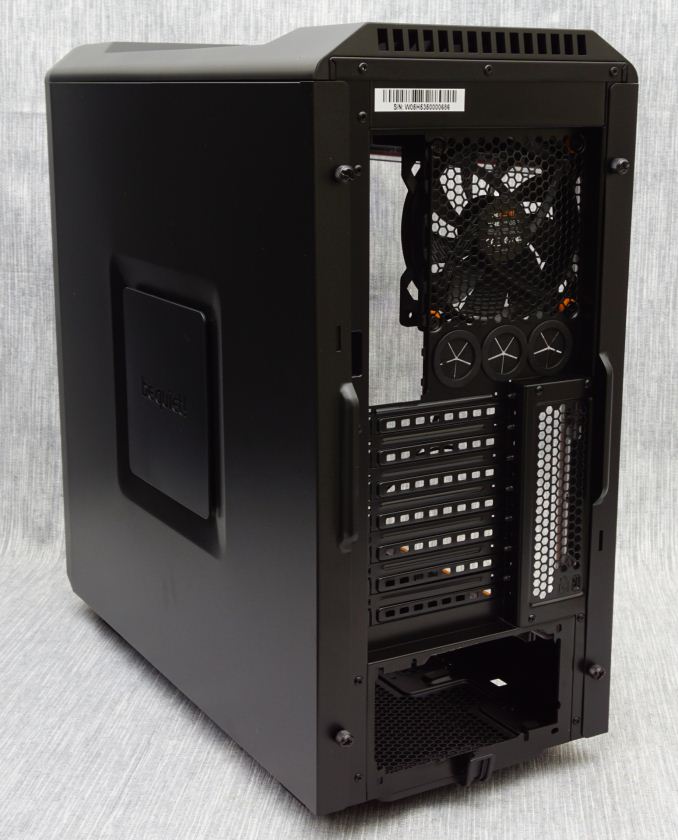
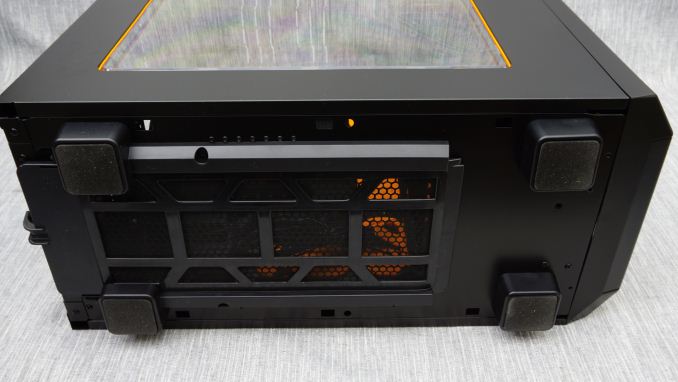








24 Comments
View All Comments
tarqsharq - Thursday, November 17, 2016 - link
Interesting case, but are those Radeon 5850's in there?!RaichuPls - Thursday, November 17, 2016 - link
Should be reference R9 290Xs if I'm not mistaken.QinX - Thursday, November 17, 2016 - link
It says ATI Radeon on the side so those are likely HD5850's the 290X is AMD Radeon branded and the reference cooler design is different for those.NiteshD - Thursday, November 17, 2016 - link
Well if you need two GPUs to test the noise insulation, you could do far worse than those 5850s - a pair of those under load would be like a propeller aircraft!tarqsharq - Thursday, November 17, 2016 - link
True that. I saw the sides of them and had a flashback to when I used to have one... yeeeaaars ago.colinstu - Thursday, November 17, 2016 - link
they need those old cards so they can actually test how well the case can keep those cool ;)DanNeely - Thursday, November 17, 2016 - link
The thermal testing is done with fanless space heaters standing in for the CPU, GPU, etc. It's not clear what what the fans used in the advanced noise test are, I wouldn't be surprised if they're both standalone fans not fans attached to heatsinks/cards.BrokenCrayons - Thursday, November 17, 2016 - link
Since the build photos are more about helping readers put the case internal design into perspective, the use of older hardware probably isn't a big problem. Why use the latest GPU, motherboard, etc which puts it at risk of being damaged from frequent rebuilds when you can use older hardware that might already be dead or is at least expendable when putting together something that's only for photography?Ryan Smith - Thursday, November 17, 2016 - link
Correct. The 5850s are solely for photography reasons. We aren't using them for testing.marc1000 - Sunday, November 20, 2016 - link
plus they are red, and match the power cables. I do not like these loose cables, but for photography and a "worst cabling case" comparison, they are great. I imagine sleeved independent cables would be much nicer to organize, but there is no point in complaining about it. the photo works, and that's it.